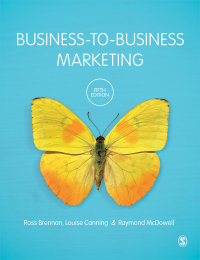The business brand Caddie has existed for some time, yet it represents one of many companies that
Question:
The business brand ‘Caddie’ has existed for some time, yet it represents one of many companies that most people have never heard of, despite the fact that products sold under the ‘Caddie’ brand are supplied to airport, healthcare, hospitality, logistics and retail customers. The Caddie brand is owned by the French firm ‘Les Ateliers Réunis’ S.A.S., which has its head office and main production facility at Drusenheim, France. Founded in 1928, the company first used its wire-processing skills to supply the poultry industry. Its core expertise is still based on steel wire, but this has been extended to the manipulation of and combination with other materials, such as plastics, to create, for example, carts, roll cages and trolleys which can be used to move and store, amongst other things, retail merchandise (not chickens!). Though you might not recognize the name, the ‘Caddie’ brand is registered in over 70 countries and the company uses a network of 130 agents to target potential customers around the world.
Major retail clients include Aldi, Carrefour and Weldom, and if you happen to fly via Paris Charles de Gaulle or Orly airports then you will likely push one of the trolleys that the company designed and built. Further afield, as you make your way through Cairo airport, you will find yourself offloading your case from the luggage belt onto one of Caddie’s trolleys in the arrivals lounge. Caddie’s retail interests extend beyond trolleys into retail shelving and displays, into technology for moving merchandise around. Looking at trolleys themselves, they may seem quite simple but they are important in the retail experience; try carrying more than six items in your arms and you will see the need. The facilitating role can be particularly acute at an airport; after the car park, the trolley may be the first real contact that a traveller has with the airport and it is certainly what brings them from the outside world right into the heart of the airport experience. The facilitating role at its most functional, of course, is embodied in those workhorses of retail replenishment, the roll cage. The alternative to transporting upwards of 500 kg of merchandise is many trips to and from the stock room – not a recipe for retail efficiency.
Caddie’s range of products for storing and transporting items serve different needs, according to sector. For example, 1. Retail:
(a) shopping trolleys with different sizes, shapes, capacities, castors, child seating configurations and stacking space requirements;
(b) garden and DIY trolleys, with different shapes, basket or tray configurations and load capacities;
(c) shopping baskets with different materials, sizes, weights and capacities;
(d) roll cages with different finishes, chassis bases, numbers of sides and stacking space requirements;
2. Airport – airport luggage trolleys with different sizes, shapes, weights, stacking space requirements and customer purposes;
3. Hospitality – hotel reception, housekeeping and room service trolleys of different sizes, shapes and stacking or storage space as well as, in the case of the latter, the capacity to keep items cool or warm;
4. Hospitals – units to transport sterile materials/equipment, to evacuate medical waste, to handle staff and patient linen.
QUESTIONS
1. Describe how the life-cycle concept might apply to Caddy’s shopping trolleys, and discuss the extent to which the life-cycle for roll cages is the same as for shopping trolleys.
2. Generate some ideas for new product development that may extend the existing technology platform for trolleys .
3. Generate ideas of how Caddy might harness the evolution of digital technologies, AI and smart products to create its next generation of shopping trolleys that might appeal both to end-customers and retailers. (To help you, take a look at www.caper.ai.)
4. On the basis of screening in a group, take one of the ideas generated in (2) or (3) and develop it further, determining:
key contributors to the development process and end product end-customer acceptance for the concept.
Step by Step Answer:

Business To Business Marketing
ISBN: 9781526494399,9781529726176
5th Edition
Authors: Ross Brennan , Louise Canning , Raymond McDowell





